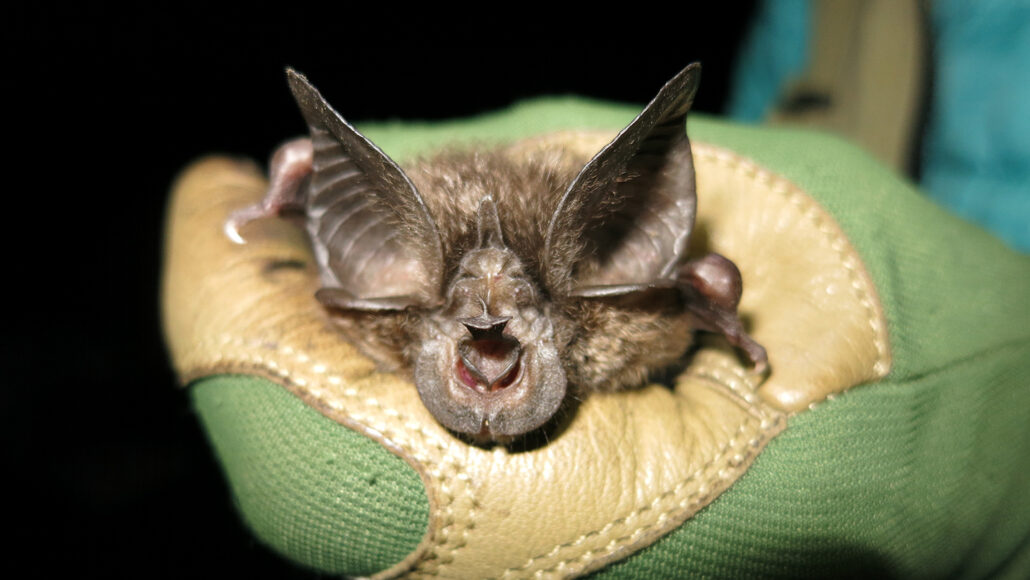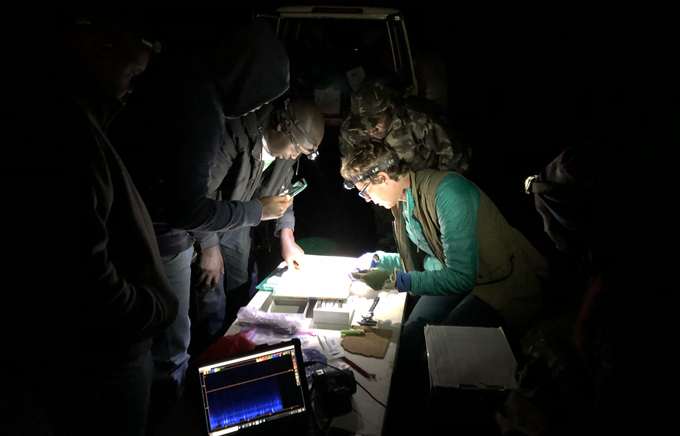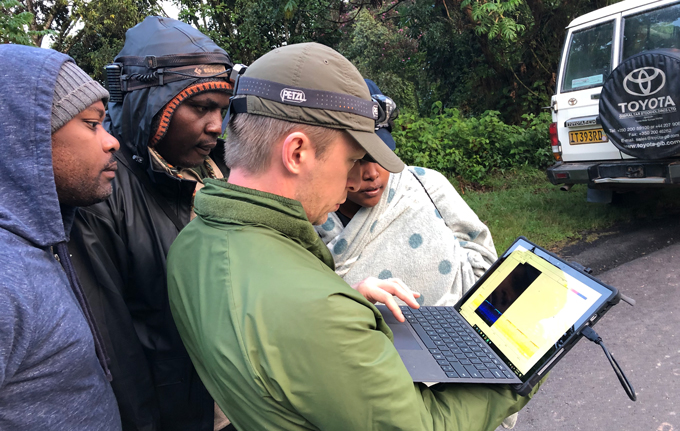Now the first recording of the Hill’s horseshoe bat’s echolocation call may help find more

This critically endangered Hill’s horseshoe bat (Rhinolophus hilli), which was released after scientists measured its features, marks the first recorded observation of the species since 1981.
JON FLANDERS, BAT CONSERVATION INTERNATIONAL
By Anna Gibbs
Julius Nziza still remembers the moment vividly. Just before dawn on a chilly January morning in 2019, he and his team gently extracted a tiny brown bat from a net purposely strung to catch the nocturnal fliers. A moment later, the researchers’ whoops and hollers pierced the heavy mist blanketing Rwanda’s Nyungwe National Park. The team had just laid eyes on a Hill’s horseshoe bat (Rhinolophus hilli), which scientists hadn’t seen for nearly four decades.
Nziza, a wildlife veterinarian at Gorilla Doctors in Musanze, Rwanda, and a self-described “bat champion,” had been looking for the critically endangered R. hilli since 2013. For several years, Nziza and Paul Webala from Maasai Mara University in Narok, Kenya, with the help of Nyungwe park rangers, surveyed the forest for spots where the bats might frequent. They didn’t find R. hilli, but it helped them narrow where to keep looking.
In 2019, the team decided to concentrate on roughly four square kilometers in a high-elevation region of the forest where R. hilli had last been spotted in 1981. Accompanied by an international team of researchers, Nziza and Webala set out for a 10-day expedition in search of the elusive bat. It wasn’t rainy season yet, but the weather was already starting to turn. “It was very, very, very cold,” Nziza recalls.
Every night, from sunset until close to midnight, the researchers stretched nets across trails, where bats are most likely to fly, and kept watch. Then, after a few hours of rest, they woke early to check the traps again. It was cold enough that the bats could die if stuck too long.
At 4 a.m. on the fourth day, the researchers caught a bat with the distinctive horseshoe-shaped nose of all horseshoe bat species. But it looked slightly different from others they had captured. This one had darker fur and a pointed tip on its nose.
Everyone began shouting: “This is it!”

After a moment of celebration at 4 a.m., the research team began studying features of the specimen to see if what they caught was indeed R. hilli.
JON FLANDERS, BAT CONSERVATION INTERNATIONAL
The researchers felt “almost 99 percent sure” they had found the lost bat. “We had a couple beers in the evening,” Nziza says. “It was worth celebration.” To be 100 percent sure, though, the team needed to compare its specimen to past ones of R. hilli. Fortunately, there were two in museums in Europe.
That’s because this isn’t the first time that R. hilli was lost, then found, to science. Victor van Cakenberghe, a retired taxonomist at the University of Antwerp in Belgium, rediscovered R. hilli 17 years after it was first seen in 1964. He says he still remembers finding the bat tangled in a mist net strung across a river. He kept the specimen and brought it back to a Belgian museum.
Nearly 40 years later, Nziza and colleagues compared the measurements of their bat, which was released into the wild, to the preserved bat. At long last, it can be confidently said that R. hilli was rediscovered again, researchers report March 11 in a preprint submitted to Biodiversity Data Journal.
And, for the first time ever, the scientists recorded R. hilli’s echolocation call. Now, the rangers can use acoustic detectors to keep an eye — or rather, an ear — on the bat (SN: 10/23/20). In nine months, they’ve already captured R. hilli calls from eight different locations in the same small area.
Bat song
The last time scientists saw a Hill’s horseshoe bat was in 1981. An international team rediscovered the species in 2019 and, for the first time, recorded its echolocation call to help prevent it from being lost to science once again.
The researchers felt “almost 99 percent sure” they had found the lost bat. “We had a couple beers in the evening,” Nziza says. “It was worth celebration.” To be 100 percent sure, though, the team needed to compare its specimen to past ones of R. hilli. Fortunately, there were two in museums in Europe.
That’s because this isn’t the first time that R. hilli was lost, then found, to science. Victor van Cakenberghe, a retired taxonomist at the University of Antwerp in Belgium, rediscovered R. hilli 17 years after it was first seen in 1964. He says he still remembers finding the bat tangled in a mist net strung across a river. He kept the specimen and brought it back to a Belgian museum.
Nearly 40 years later, Nziza and colleagues compared the measurements of their bat, which was released into the wild, to the preserved bat. At long last, it can be confidently said that R. hilli was rediscovered again, researchers report March 11 in a preprint submitted to Biodiversity Data Journal.
And, for the first time ever, the scientists recorded R. hilli’s echolocation call. Now, the rangers can use acoustic detectors to keep an eye — or rather, an ear — on the bat (SN: 10/23/20). In nine months, they’ve already captured R. hilli calls from eight different locations in the same small area.
Bat song
The last time scientists saw a Hill’s horseshoe bat was in 1981. An international team rediscovered the species in 2019 and, for the first time, recorded its echolocation call to help prevent it from being lost to science once again.
A Hill’s horseshoe bat echolocation call
BAT CONSERVATION INTERNATIONAL

Julius Nziza (far left) and Paul Webala (second from left) work with the research team to capture the first-ever audio recording of Hill’s horseshoe bat’s echolocation call.
WINIFRED FRICK, BAT CONSERVATION INTERNATIONAL
The team published its data to the open-access Global Biodiversity Information Facility in hopes of speeding up conservation efforts for the bat. Africa is home to over 20 percent of the world’s bats, but with a longstanding research focus on bats in Europe and the Americas, little is known about African bat species.
“It’s a whole new thing,” Nziza says. “That’s why everybody’s excited.”
sciencenews.org
CITATIONS
J. Flanders et al. Rediscovery of the critically endangered Hill's horseshoe bat (Rhinolophus hilli) and other new records of bat species in Rwanda. ARPHA Preprints. Posted March 11, 2022. doi: 10.3897/arphapreprints.e83547.
About Anna Gibbs
E-mail
Twitter
Anna Gibbs is the spring 2022 science writing intern at Science News. She holds a B.A. in English from Harvard College.
The team published its data to the open-access Global Biodiversity Information Facility in hopes of speeding up conservation efforts for the bat. Africa is home to over 20 percent of the world’s bats, but with a longstanding research focus on bats in Europe and the Americas, little is known about African bat species.
“It’s a whole new thing,” Nziza says. “That’s why everybody’s excited.”
sciencenews.org
CITATIONS
J. Flanders et al. Rediscovery of the critically endangered Hill's horseshoe bat (Rhinolophus hilli) and other new records of bat species in Rwanda. ARPHA Preprints. Posted March 11, 2022. doi: 10.3897/arphapreprints.e83547.
About Anna Gibbs
Anna Gibbs is the spring 2022 science writing intern at Science News. She holds a B.A. in English from Harvard College.
No comments:
Post a Comment